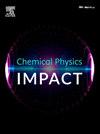揭示戊氟利多和BMS-754,807: NUDT5抑制在乳腺癌中的治疗作用
IF 4.3
Q2 CHEMISTRY, PHYSICAL
引用次数: 0
摘要
乳腺癌(BC)仍然是女性癌症相关死亡的主要原因,激素受体阳性亚型经常对标准治疗产生耐药性。Nudix水解酶5 (NUDT5)是adp核糖代谢、DNA修复和激素驱动转录不可或缺的酶,已成为一个有希望的治疗靶点。本研究采用计算药物发现方法从drug - lib数据库中fda批准的化合物中鉴定潜在的NUDT5抑制剂。虚拟筛选和分子对接显示了四个有希望的候选药物:阿非昔那新、潘氟利多、贝拉培酮和BMS-754,807。详细的分子动力学模拟验证了它们的稳定性,并进行了轨迹分析,包括RMSD、RMSF和基于pca的自由能景观,突出了一致和有利的相互作用。其中BMS-754,807表现出最强的抑制潜力,结合稳定,氢键相互作用优越,自由能值最低。这些发现强调了这些化合物的治疗前景,特别是BMS-754,807,针对激素抵抗性乳腺癌。未来的体外和体内研究将是确认这些结果和推进这些抑制剂临床应用的关键。本文章由计算机程序翻译,如有差异,请以英文原文为准。

Unveiling the therapeutic role of penfluridol and BMS-754,807: NUDT5 inhibition in breast cancer
Breast cancer (BC) remains a leading cause of cancer-related mortality among women, with hormone-receptor-positive subtypes frequently developing resistance to standard therapies. Nudix hydrolase 5 (NUDT5), an enzyme integral to ADP-ribose metabolism, DNA repair, and hormone-driven transcription, has emerged as a promising therapeutic target. This study employed computational drug discovery approaches to identify potential NUDT5 inhibitors from FDA-approved compounds in the Drug-Lib database. Virtual screening and molecular docking revealed four promising candidates: Afacifenacin, Penfluridol, Belaperidone, and BMS-754,807. Detailed molecular dynamics simulations validated their stability, with trajectory analyses, including RMSD, RMSF, and PCA-based free energy landscapes, highlighting consistent and favourable interactions. Among these, BMS-754,807 demonstrated the strongest inhibitory potential, with stable binding, superior hydrogen bonding interactions, and the lowest free energy values. These findings emphasize the therapeutic promise of these compounds, particularly BMS-754,807, in targeting hormone-resistant breast cancer. Future in vitro and in vivo studies will be crucial to confirm these results and advance these inhibitors toward clinical applications.
求助全文
通过发布文献求助,成功后即可免费获取论文全文。
去求助
来源期刊

Chemical Physics Impact
Materials Science-Materials Science (miscellaneous)
CiteScore
2.60
自引率
0.00%
发文量
65
审稿时长
46 days
 求助内容:
求助内容: 应助结果提醒方式:
应助结果提醒方式:


